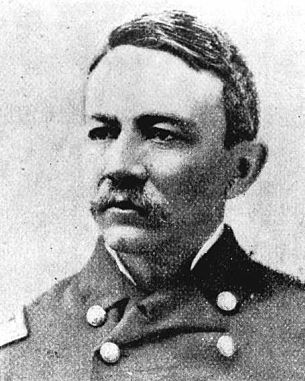Michael A. Healy
| Michael A. Healy | |
|---|---|
 |
|
| Nickname(s) | "Hell Roaring Mike" |
| Born |
September 22, 1839 Jones County, Georgia, U.S. |
| Died | August 30, 1904 (aged 64) San Francisco, California, U.S. |
| Buried at | Colma, California, U.S. |
| Allegiance |
|
| Service/branch | |
| Years of service | 1865–1903 |
| Rank | Captain (USRCS) |
| Commands held | USRC Rush USRC Corwin USRC Bear USRC McCulloch USRC Thetis |
Michael Augustine Healy (September 22, 1839 – August 30, 1904) was an American captain in the United States Revenue Cutter Service (predecessor of the United States Coast Guard).
Following U.S. Secretary of State William H. Seward's Alaska purchase of the vast region in 1867, Healy patrolled the 20,000 miles (32,000 km) of Alaskan coastline for more than 20 years, earning great respect from the natives and seafarers alike. After commercial fishing had depleted the whale and seal populations, his assistance with introduction of Siberian reindeer helped prevent starvation among the native Alaskans.
Nicknamed "Hell Roaring Mike," Healy was the son of an Irish-born planter and his African-American slave and was later recognized as the first man of African-American descent to command a ship of the United States government. The author Jack London was inspired by his command of the USRC Bear. Commissioned in 1999, the USCGC Healy was named in his honor.
Healy was born near Macon, Georgia, in 1839, the fifth of ten children of Michael Morris Healy, an Irish immigrant planter, and Mary Eliza Smith, his common-law wife, a mixed-race African-American slave. The senior Healy was born in 1795 and emigrated from County Roscommon in 1818. By a land lottery and purchase, he eventually acquired 1,500 acres (6.1 km2) of land in Jones County, Georgia, across the Ocmulgee River from the market town of Macon. He became one of the more successful planters, and came to own 49 slaves for his labor-intensive cotton plantation. Among them was 16-year-old Mary Eliza Smith (or Clark), whom he took as his wife in 1829. Mary Eliza Healy has been described in various accounts as "slave" and "former slave," and as mulatto and black. Under the partus principle in slave law, the Healy children were born into slavery by being born to an enslaved mother. They could not be formally educated in Georgia, and their manumission required legislative approval, then nearly impossible to obtain. As the children could pass for white due to their mixed descent, their father decided to send them North for education and their futures, as did some other wealthy white planters for their mixed-race children.
...
Wikipedia
